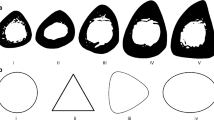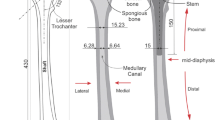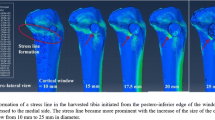Abstract
Periosteal surface pressures have been shown to inhibit bone formation and induce bone resorption, while tensile strains perpendicular to the periosteal surface have been shown to inhibit bone resorption and induce new bone deposition. A new computational model was developed to incorporate these experimental findings into simulations of spontaneous bone straightening in children with congenital posteromedial bowing of the tibia. Three-dimensional finite element models of the periosteum were used to determine the relationships between the defect angle and the distribution of bone surface pressures and strains due to growth-generated tensile strains in the periosteum. These relationships were incorporated into an iterative simulation to model development of a growing, bowed tibia with an initial defect angle of 27°. When periosteal loads were included in the simulation, the defect angle decreased to 10° after 2 years, and the bone straightened by an age of 25 years. When periosteal loads were not included in the simulation, the defect angle decreased to 23° after 2 years, and a defect angle of 9° remained at an age of 25 years. A “modeling drift” bone apposition/resorption pattern appeared only when periosteal loads were included. The results suggest that periosteal pressures and tensile strains induced by bone bowing can accelerate the process of bone straightening and lead to more complete correction of congenital bowing defects. Including the mechanobiological effects of periosteal surface loads in the simulations produced results similar to those seen clinically, with rapid straightening during the first few years of growth.
Similar content being viewed by others
References
Amprino R (1985) The influence of stress and strain in the early development of shaft bones. An experimental study on the chick embryo tibia. Anat Embryol (Berl) 172(1): 49–60
Beaupré GS, Orr TE et al (1990) An approach for time-dependent bone modeling and remodeling–theoretical development. J Orthop Res 8(5): 651–661
Bertram JE, Polevoy Y et al (1998) Mechanics of avian fibrous periosteum: tensile and adhesion properties during growth. Bone 22(6): 669–675
Carpenter RD, Carter DR (2008) The mechanobiological effects of periosteal surface loads. Biomech Model Mechanobiol 7(3): 227–242
Carter DR, Fyhrie DP et al (1987) Trabecular bone density and loading history: regulation of connective tissue biology by mechanical energy. J Biomech 20(8): 785–794
Cheema JI, Grissom LE et al (2003) Radiographic characteristics of lower-extremity bowing in children. Radiographics 23(4): 871–880
Ek AC, Gustavsson G et al (1987) Skin blood flow in relation to external pressure and temperature in the supine position on a standard hospital mattress. Scand J Rehabil Med 19(3): 121–126
Epker BN, Frost HM (1965) Correlation of bone resorption and formation with the physical behavior of loaded bone. J Dent Res 44: 33–41
Feik SA, Storey E et al (1987) Stress induced periosteal changes. Br J Exp Pathol 68(6): 803–813
Frost HM (1982) Mechanical determinants of bone modeling. Metab Bone Dis Relat Res 4(4): 217–229
Frost HM (1987) Osteogenesis imperfecta. The set point proposal (a possible causative mechanism). Clin Orthop Relat Res 216: 280–297
Fyhrie DP, Carter DR (1986) A unifying principle relating stress to trabecular bone morphology. J Orthop Res 4(3): 304–317
Glucksmann A (1941) The role of mechanical stresses in bone formation in vitro. J Anat 76: 231–239
Hofmann A, Wenger DR (1981) Posteromedial bowing of the tibia. Progression of discrepancy in leg lengths. J Bone Joint Surg Am 63(3): 384–388
Iwasaki LR, Crouch LD et al (2004) The velocity of human orthodontic tooth movement is related to stress magnitude, growth status, and the ratio of cytokines in gingival crevicular fluid. In: Davidovitch Z, Mah J (eds) Biological mechanisms of tooth movement and craniofacial adaptation. Harvard Society for Advancement of Orthodontics, Boston, pp 137–147
Johari AN, Sinha M (1999) Remodeling of forearm fractures in children. J Pediatr Orthop B 8(2): 84–87
Lanyon LE, Hampson WG et al (1975) Bone deformation recorded in vivo from strain gauges attached to the human tibial shaft. Acta Orthop Scand 46(2): 256–268
Levenston ME, Beaupré GS et al (1998) Loading mode interactions in simulations of long bone cross-sectional adaptation. Comput Methods Biomech Biomed Engin 1(4): 303–319
Loboa EG, Fang TD et al (2004) Mechanobiology of mandibular distraction osteogenesis: experimental analyses with a rat model. Bone 34(2): 336–343
McCammon RW (1970) Human growth and development. Springfield, Illinois, Charles C. Thomas
Mosley JR, Lanyon LE (1998) Strain rate as a controlling influence on adaptive modeling in response to dynamic loading of the ulna in growing male rats. Bone 23(4): 313–318
O’Driscoll SW, Saris DB et al (2001) The chondrogenic potential of periosteum decreases with age. J Orthop Res 19(1): 95–103
Pappas AM (1984) Congenital posteromedial bowing of the tibia and fibula. J Pediatr Orthop 4(5): 525–531
Peterman MM, Hamel AJ et al (2001) In vitro modeling of human tibial strains during exercise in micro-gravity. J Biomech 34(5): 693–698
Reilly DT, Burstein AH (1975) The elastic and ultimate properties of compact bone tissue. J Biomech 8(6): 393–405
Roberts MD, Hart RT (2005) Shape adaptation of long bone structures using a contour based approach. Comput Methods Biomech Biomed Engin 8(3): 145–156
Ruff CB, Hayes WC (1982) Subperiosteal expansion and cortical remodeling of the human femur and tibia with aging. Science 217(4563): 945–948
van der Meulen MC, Beaupré GS et al (1993) Mechanobiologic influences in long bone cross-sectional growth. Bone 14(4): 635–642
Weinans H, Blankevoort L (1995) Reconstruction of bone loading conditions from in vivo strain measurements. J Biomech 28(6): 739–744
Author information
Authors and Affiliations
Corresponding author
Rights and permissions
About this article
Cite this article
Carpenter, R.D., Carter, D.R. Computational simulation of spontaneous bone straightening in growing children. Biomech Model Mechanobiol 9, 317–328 (2010). https://doi.org/10.1007/s10237-009-0178-x
Received:
Accepted:
Published:
Issue Date:
DOI: https://doi.org/10.1007/s10237-009-0178-x




